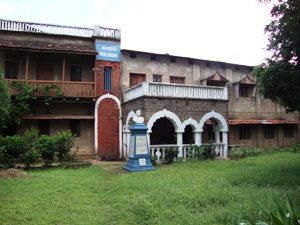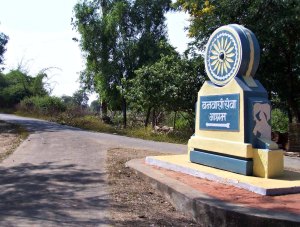Overview

Main building of Banwasi Seva Ashram

A road pointer to the Ashram
Banwasi Seva Ashram came into existence when its primary work area – South Sonbhadra (then South Mirzapur) – was in crisis, due to a severe famine in 1954. Credit goes to its founding father, the then Chief Minister, Govind Vallabh Pant, who thought of research and development needed to achieve the objective of developing the tribals and leased out 250 acres of forest land for Banwasi Seva Ashram. Its founder members were experienced social workers.
The Ashram’s approach is to go into the depth of the problem faced by its beneficiary community, to find appropriate solutions and then implement the programmes with the involvement of the beneficiaries. The framework developed for the involvement and improvement of the beneficiary community is named Gramswaraj Sabha Sangathan.
At present, the Ashram has nine major departments: Women’s Empowerment, Education, Khadi and Village Industry, Agriculture, Animal Husbandry, Health, Environment, Support to Other Volunteer Groups, Gram Nirman or Village Development with and thirteen Village Development Centres.
Ashram staff at present (March 2015) is 126 (114 locals) who receive living allowances and basic facilities. There are 21 women in the staff out of whom four are in an administrative position. In addition, 32 volunteers are working on various short term projects.
The problems addressed:
- Repeated occurrence of drought and famine
- Degradation of forest and scarcity of water
- Bondage with moneylender of land and person
- Lack of basic infrastructure facilities, education, health, PDS
- Illiteracy and ignorance of rules of the Government
- Witchcraft and social taboos
- Land rights and irregularities in land records and
- Rehabilitation of people displaced due to industrialisation
- Problems faced by village craftsmen and increasing unemployment
- Environmental pollution associated with increasing industrialisation
- Gender inequality, child rights
The development activities undertaken so far in Sonbhadra area:
- Water and soil conservation, land development
- Whole village development projects
- Employment oriented apprentice training in crafts and services needed for the development activity and for employment elsewhere
- Rural health education and rural health service
- Women’s development and empowerment
- Securing rural entitlements
- Public interest litigation in Supreme Court for land rights, rights of the displaced and bonded labour
- Study and representation of environmental pollution problem in south Sonbhadra at different levels
- Education: schools, non-formal education, total literacy campaign, skills development, life orientation of adolescents and youth through camps
Extension of benefits of learning to other areas through voluntary organisations under different schemes:
- Rural entitlement and legal support programme
- Financial support and guidance to emerging promising volunteers through Mahatma Gandhi Mission
- Total literacy campaign in five states
- Nagarik Sadbhavana Manch
- Survey and development planning for four blocks in Uttarakhand
- Relief and rehabilitation at the time of calamities in Mirzapur and Bihar
(Schemes 1 to 4 are underway in Uttar Pradesh, Madhya Pradesh, Bihar, Orissa and Assam)
